Jones, Owen (architect and designer): related collections

Owen Jones (1809-1974) was one of the most influential architects and designers of Victorian Britain. Born in London to Welsh parents, he trained as an architect in the 1820s. During the 1830s, Jones undertook a grand tour through the Mediterranean and North Africa, spending six months at the Alhambra in Granada. On his return in 1834, he began his first major work, Plans, Elevations, Sections and Details of the Alhambra, which appeared in several parts (to form two volumes) between the years 1842 to 1845, and was printed using chromolithography – a multi-colour printing process in which each colour is applied from a separate lithographic stone or plate. This pioneering use of colour printing helped to popularise polychromatic design, the use of multiple colours within a single artwork or space, in British architecture.

Jones was a key figure in the Great Exhibition of 1851, overseeing the arrangement of the exhibits and the decoration of the Crystal Palace. After the Great Exhibiton, Jones’s design theories were realised in his best-known work, The Grammar of Ornament (1856), which brought together one hundred richly coloured plates illustrating thirty-seven principles of design and colouring.
Jones collaborated with a number of publishers and printers throughout his career, but his most enduring partnership was with the De La Rue company. Beginning in the mid-1840s, he created designs for a wide variety of their products, including playing cards, postage stamps, chessboards, almanacs, menus, calendars, biscuit-tin labels, endpapers and diaries. Many of these designs remained in production well into the twentieth century. It was through De La Rue that Jones was commissioned in 1851 to design the garter and buckle trade mark for the Reading-based Huntley & Palmers, which went on to become the distinctive and internationally recognised symbol of the biscuit company.

Although the University of Reading does not hold a single dedicated Owen Jones Collection, his work is well represented across our holdings within our Rare Books and Archive Collections – particuarly within our Printing Collection, which includes many of Jones’s published works; original artwork for the De La Rue printing firm in the De La Rue Archive; designs featured on Huntley & Palmers packaging in the Huntley & Palmers Archive; and the Great Exhibition Collection (1851), with items that represent the 1851 Exhibition where Jones oversaw the interior decoration of the Crystal Palace and the arrangement of its exhibits.
Original Artwork by Owen Jones in our Archive Collections
De La Rue Archive – original signed artwork by Jones for diaries, calendars and product packaging.
MS 3975 – Original and printed designs by Owen Jones and pupils; designs for calendars and packaging, associated with De La Rue and Huntley and Palmers
Published Works by Owen Jones in our Rare Books Collections
The Sermon on the Mount (1844)
Call number: LONGMAN COLLECTION–001
Flowers and their Kindred Thoughts / poetry by M. A. Bacon; designs by Owen Jones (1848)
Call number: PRINTING COLLECTION FOLIO–582.13-BAC
Holy Matrimony / illuminated by Owen Jones (1849)
Call number: PRINTING COLLECTION–265.5-CHU
The Preacher (1849)
Call number: PRINTING COLLECTION FOLIO–223.8
Description of the Egyptian Court erected in the Crystal Palace / by Owen Jones, architect, and Joseph Bonomi, sculptor; with an historical notice by Samuel Sharpe (1854)
Call number: GREAT EXHIBITION–08/28
The Grammar of Ornament / illustrated by examples from various styles of ornament. One hundred folio plates, drawn on stone by F. Bedford and printed in colours by Day and Son (1856)
Call number: PRINTING COLLECTION LARGE–745-JON
Find out more about The Grammar of Ornament from our featured item article here.
Plans, Elevations, Sections, and Details of the Alhambra / from drawings taken on the spot in 1834 by Jules Goury, and in 1834 and 1837 by Owen Jones; with translation of the Arabic inscriptions and historical notice by Pasqual de Gayangos (1842–1845)
Call number: OVERSTONE-SHELF LARGE 33J/05 VOL. 1
The Psalms of David / illuminated by Owen Jones (1861)
Call number: PRINTING COLLECTION LARGE–223.2
Scenes from The Winter’s Tale / illuminators Owen Jones and Henry Warren; on stone by A. Warren (1866)
Call number: PRINTING COLLECTION FOLIO–822.33-JON
The Grammar of Ornament / by Owen Jones; illustrated by examples from various styles of ornament. One hundred and twelve plates (1868)
Call number: PRINTING COLLECTION FOLIO–745-JON
Other related collections
Huntley & Palmers Archive – while it does not contain original artwork by Jones, the archive includes examples of the firm’s packaging and design work.
Great Exhibition Collection (1851) – contains around 150 printed books and periodicals, plus pamphlets and ephemera, approximately 50 prints, and some objects documenting the 1851 Exhibition, where Jones oversaw the interior decoration of the Crystal Palace and the arrangement of its exhibits.
